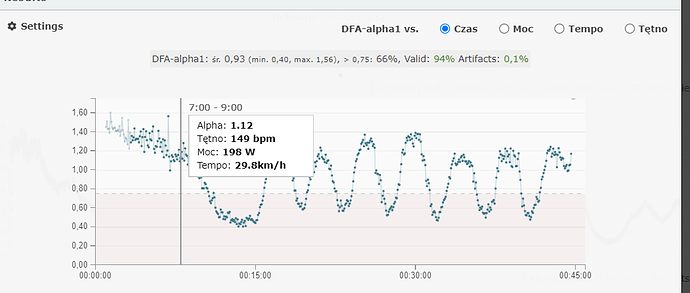That is surprising, considering it is the strap that is gathering the electrical signs, not the module. Thanks for the tip.
Having compared both the tickr and Polar H10 side by side, the tickr reports many artifacts (0
or 1 on H10 when ticker may be reporting ~40) and the DFA a1 difference between the two is pretty stark.
I would have no confidence in tickr HRV data.
I downloaded your fit file and uploaded to fitfileviewer.com and there are no Alpha1 or EPOC fields in the records 
Garmin - TICKR - ANT+ using the Polar H10 STRAP.
It’s better than when I was using the TICKR + 3rd Party Strap for sure (plot is available in one of my posts above)
But… this TICKR of mine is a bit wonky, midway thru the ride, It crapped out and read like 30% lower (i manually checked against pulse) which was what triggered the readings around the 1hr mark i think.
Somebody use AlphaHRV on Edge 530 via BLE and it works? (always connecting…, works via ANT+ but lots artifacts).
Works perfect on FR945 via BLE.
@Marcin_Stefanowicz There’s an issue on EDge530/830/1030plus that is also being reported by other developers.
Seems that Garmin must fix some bug in the firmware.
See following thread in Garmin developers forum:
Don’t forget that the areas on the strap which gathe the data move to the left as well
It looks to me that it was starting to drop very nicely and about to cross at 160bpm then you seemed to generate a lot of noisy data. What were the artifacts around that level? These charts need a bit of interpretation as the data is not clear cut. If it was me I’d use 160 until I got a few more readings in to confirm it. Does 160 feel about right to you? Also LT1 appears to be affected by all sorts of things on any particular day. Temperature, fatigue state, nutrition, general state of stress etc. can all affect it. That is the same however you measure it.
I can’t exactly pinpoint the number, but i think it’s about 0.6 - 1.9%
I’m not exactly a fan of the ramp test protocol…  and I don’t think I wanna repeat it often either. 160 thereabout feels about right i think. But we shall see… TX
and I don’t think I wanna repeat it often either. 160 thereabout feels about right i think. But we shall see… TX
Try riding a constant power interval keeping HR as close to 160 but not going over. If you can do 30mins or so without going over 0.75 it will be in the right ball park. If it never goes near it then it’s probably a bit high. If it goes through after about 5-10 mins it may be a bit high.
Hi, I have done another test with the latest alpha1 datafield and result looks much more correct for me, alpha1 is also much more “stable”
I did a new test and in my case DFA a1 is less than 0.75 for a power of about 250W. At 250W I have a heart rate of 158bpm and lactate of 2mmol/l.
However, my LT1 threshold is at 200W and heart rate 145bpm and lactate 1.4mmol/l.
I learned something like this from the lab that did my testing:
“The concept of a 2mmol/l threshold is anachronistic and unlikely to be used. Based on lactate, the first threshold is determined, among other things, when the increase in concentration of this metabolite is a minimum of 0.4mmol/l relative to the previous measurement. This is verified, of course, by gasometric values, where the dynamics of the increase in the value of, among others, the respiratory equivalent for oxygen or the oxygen pressure in end-expiratory air is checked.”
Translated with www.DeepL.com/Translator (free version)
An entire episode dedicated to the DFAAlpha1 app, with an interview with the creators of the app. In Spanish
Just to remind you that he was the one who published the first validations, soon there will be a study comparing with lactate that has already been accepted for validation where the results are the same. All methods are not 100% perfect. Then it is not the same to estimate thresholds with alpha-1, than to train based on alpha-1 values, for example 1-0.75 , 0.75-0.5 etc. …
There are more validation studies, here I show you the image of one that has been done and is going to be validated now.
Still Bruce Rogers has several papers with validation.
I understand what you are saying about all methods not being 100% perfect. There is a lot discussion about individual lactate curves even. I don’t understand what you are saying in the last part though.
Just for curiosity, what is your DFA a1 @ “LT1 threshold 200W, HR 145bpm and lactate 1.4mmol/l” ?
One thing that i notice with DFA a1, is that its highly influence by respiration, i.e. if you force, even slightly, frequency or amplitude, DFA a1 will be deeply changed, even at << LT1 levels.
No, but I have seen that once you get below 60-65% battery on the Polar, the remaining % drops much faster. I now replace the battery when it get’s around 60%, just to be sure.
That is about twice a year with 4-5 workouts a week.
Intervals intensity?


